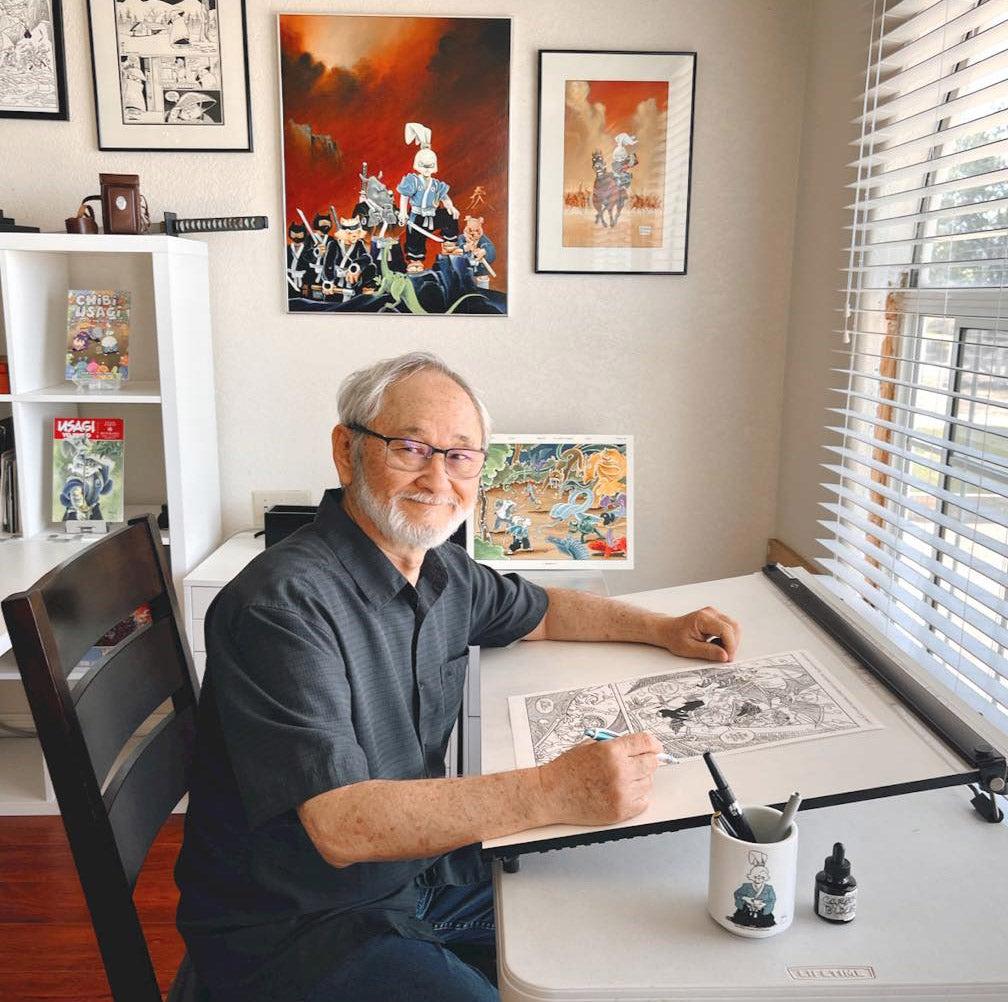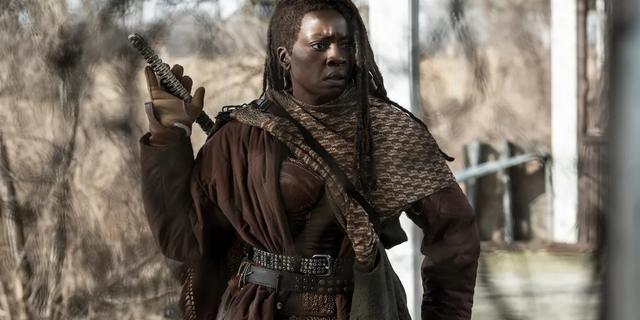If you click on a link and make a purchase we may receive a small commission. Read our editorial policy.
Stan Sakai shares his passion for Usagi Yojimbo and Netflix's Samurai Rabbit
The prolific Stan Sakai talks about designing broccoli and making heroes for Usagi Yojimbo and the Netflix spinoff, Samurai Rabbit

For nearly 40 years, Eisner Award-winning comic book creator Stan Sakai has written and illustrated acclaimed samurai stories in his comic book series Usagi Yojimbo. Created by Sakai in 1984, the comic is set in a feudal Japan populated by anthropomorphized animals, with the honorable swordsman Miyamoto Usagi wandering the country and defending the oppressed.
As Sakai crafts new tales for the character, with the classic Usagi Yojimbo stories receiving full color volumes from IDW Publishing, the series has been adapted into an original animated series on Netflix, Samurai Rabbit: The Usagi Chronicles, following the adventures of Usagi’s distant descendant Yuichi Usagi and his friends.
In an interview with PopVerse, Sakai shares his involvement in helping bring Samurai Rabbit: The Usagi Chronicles to life, reflects on Usagi Yojimbo’s extensive comic book history, and teases where the ronin rabbit is up to next in his continuing adventures.

Popverse: Stan, after all these years, how is it finally seeing Usagi Yojimbo star in Samurai Rabbit: The Usagi Chronicles on Netflix?
Stan Sakai: Well, my Usagi isn’t the star, it’s his descendant that stars, however, my Usagi does make frequent appearances. It feels great, I’ve come so close so many times to have a TV series or feature film about Usagi and some of the people involved were A-listers in Hollywood, however, it never made it to this point so it was great to see him on the screen.
What was it about this particular production that made this project special?
Everything just came together. Now, we’ve got streaming services and that was something we did not have when we were looking for an Usagi TV series or a movie, that’s a big thing. With Gaumont, Gaumont is the oldest film [studio] in the world and we’ve got them and their US division behind us. Khang Le, who did the production artwork and design, is just phenomenal.
The story came together nicely and I’ve interacted every step of the way with the talent, whether it be story or talent or even props, I was very much involved with everything.
I had to approve things like the look of broccoli because Usagi’s aunt has a farm where she grows broccoli so I had to approve the broccoli designs and the rocks around it. [laughs] I wasn’t aware of the level of detail getting in animation and it was neat.
Has being a big part in the production of Samurai Rabbit influenced how you’ve approached making the Usagi Yojimbo comics or has there always been a separation?
There’s always been a separation and the animation is geared for a much younger audience, the demographics are from six to twelve years old. That’s actually a little older than what most animation is geared for because I was told, by the time a child turns six, they’ve already moved on to video games. [laughs]
I should say that Samurai Rabbit has been doing great, within the Top 10 [streamed] around the world, #3 in the US, and #1 in several other countries so we’re very happy with that.

With all the research into Japanese history and culture that you’ve done for the Usagi Yojimbo comic, what are you personally glad to see has translated over to the animated series?
The themes of honor and loyalty are in the series as well as the Samurai Rabbit series, but they also brought in all the mythological elements of the folklore, like the yokai, which is great. Japan has such a strong tradition of yokai as the monsters that shape its mythology and not only [does the show] have the more horrific [monsters], like the tengu, but also the really goofy ones. They did a lot more research than I thought they would and I’m very happy with it; even just the fact that they have the yokai in it because I love that portion of Japanese folklore. [laughs]
Across the research you’ve done for the comic, what Japanese cultural elements have personally surprised you the most?

I’m always surprised by things from Japanese history, mythology, and culture. One thing I did back in the day was about seaweed farming and I had never thought about seaweed farming at all. Once when my parents came back from Japan, they showed me a picture they took while passing a seaweed farm and I had never heard of seaweed farms but, of course, seaweed is such a strong part of Japanese food.
When I heard that the Peabody Museum in Salem, Massachusetts had an exhibit on seaweed farming, I went over there and visited the museum. This was before the time of cellphone cameras so I had to hand write everything in front of all of the exhibits. The last time I went to Japan, I actually did volunteer work on a seaweed farm so that was kind of neat! [laughs]
Was Samurai Rabbit always going to be about Usagi’s descendants or were there ever plans for it to be more about Usagi himself?
At first, it was going to be about Usagi… but Usagi does have a quite high body count. [laughs] We decided that since it was going to be geared for a younger audience that maybe it would be a descendant of his. They took one of my stories – Senso, a miniseries I did where Martians invade feudal Japan – and wondered what if they took some of the technology they got from those Martians, how would it affect their society generations down the line?
That was the premise, with the story taking place in a city called Neo-Edo; with Edo being the old name for Tokyo, the capital of Japan. It also takes a lot from Japanese culture, such as vending machines, pachinko parlors, karaoke bars, and things like that. It integrated everything, the old and the new, and I’m quite happy about that.

The stories with Space Usagi and Senso always threw me for a loop because so much of Usagi Yojimbo is rooted in Japanese history.
You’re right, most of my stories are very historical – within reason, of course, because it’s a rabbit – but when I did Senso, it was just pure fun. [laughs] H.G. Wells’ Martians, what if they invaded feudal Japan, with those giant spaceships? It was nice and just pure fun.
When you’re adapting Usagi into different media, be it working with Netflix for Samurai Rabbit or Usagi to have a guest role with the Teenage Mutant Ninja Turtles, what are you looking for in a potential collaboration?
If it will be fun because, for me, I could continue on with Usagi [the comic book series] and I’d be happy. But every so often, something comes along, like the Ninja Turtles or Sergio Aragonés. Even with my wife Julie, we worked on the Chibi Usagi series and that’s always been fun.
What led to the decision to color all of the older Usagi Yojimbo stories with IDW Publishing?
It had to go to color, the current Usagi [series] is in color and [the original series] had to go color. Back when I started in 1984, there were a lot of black-and-white titles, Ninja Turtles and Cerebus, there were so many black-and-white books around. Nowadays, how many black-and-white comics are out there? It’s basically all died out. The Walking Dead was probably one of the last black-and-white series.

The new stories [of Usagi] had to be in color, however, when talking to IDW, they suggested if they could color the entire library. I thought that would make it more attractive to new readers because I’ve got 37 or 38 Usagi volumes, plus you’ve got Senso and The Adventures of Nilson Groundthumper, all these other works. I’ve got about 40 books and they’re willing to color the entire story and that’s great!
Between this colorization process and the Samurai Rabbit animated series, how has it been seeing new readers approach the Usagi Yojimbo comic book series?
Usagi is a very reader-friendly book, you don’t have to know the entire history of the character to enjoy it. You can pick up almost any comic and certainly any trade collection, all you need to know is that Usagi is a samurai rabbit within 17th century Japan and you can enjoy the stories from there. The only thing about the comics is, if it’s in the middle of a long storyline, you might have to pick up some of the earlier issues, however, for the most part, you can pick up any collected books in the saga and get right into the stories.
I know you’ve answered some form of this question a lot but, you’ve been working on Usagi Yojimbo for almost 40 years now; it’s like Malcolm Gladwell’s 10,000 hours or, to keep it within Japanese cultural context, Jiro Dreams of Sushi. What keeps you creatively fulfilled with working on this story and its characters?

I own the character and the entire series and I can do whatever I want with it. Most of [the stories] are action-adventure but some of them are cultural; I did an entire story about Japanese tea ceremonies. I can do romance or my take on a Western or even science fiction. I did Space Usagi because I just wanted to draw dinosaurs and I figured I could have Usagi go to a prehistoric time or visit a dinosaur planet and [the latter] was much more interesting and that’s how Space Usagi came around.
I can do whatever I want with it, I love the character, and I have such freedom with it. My publishers, they do not see the story until I send it in fully completed so I have complete creative control over everything and that’s something most creators do not have and would give anything for. I’ve been doing this for almost 40 years and I would think I’ve earned that privilege now! [laughs]
How did the Usagi short story contribution for the benefit project Comics for Ukraine come about?
Scott Dunbier came to me with this project, Comics for Ukraine. He has such compassion for the refugees and he approached me along with a lot of other creators, some very prestigious names, and I’m very honored to be part of this project. He approached me and asked if I wanted to contribute a short story and I said that I’d have to think of a short story to do. I hung up, picked up the phone right away, and said “I’ve got a story! I’m in!” [laughs] At the time, I was dealing with a lot of deadlines but I certainly had time for this, it is such a worthwhile cause.
What elements of Japanese culture were you really excited in getting to share with the rest of the world who might not know about them?
I’m third-generation Japanese American, my dad was actually born in Hawaii, which was a territory at the time. He was stationed in Japan after the war by the US military and met my mom there and got married in Japan. The research and everything is part of my heritage and a chance for me to share my heritage with everyone else. I probably get the most out of it because, doing the research, I find out things about Japan that I did not know before.

In the early days, my mom would be one of my first resources, she was also a student of Japanese history. I would be doing a story about bakeneko, demon cats, and she knew so many of the historical figures in Japan and she'd tell me about them. With the bakeneko, I always thought it was a person transformed into a cat but she pointed out it’s a cat that transforms into a human. [laughs] Bakeneko were always in horror movies and old samurai movies so I did a bit more research about them and they’re in my yokai pantheon now.
Usagi has normally been a loner wandering Japan but now he’s got Yukichi Yamamoto by his side. Can Usagi ever be with someone else or is he destined to be alone?
Right now in the comic books, Usagi is with his cousin [Yukichi] and, when I first started out doing Usagi, he was a much younger person. He was more impulsive and brash, like a know-it-all. Now, he’s older and taken on the role of a teacher, with his much younger cousin like he was early on: Naive but, at the same time, very impulsive.
It’s nice to have Usagi as a mentor now and see how he would handle someone much younger just starting to develop into becoming a samurai; it’s a nice change for him. I don’t know how long Yukichi will be in the series but I love that character so he’ll stick around for quite a while, it’s a nice dynamic between those two.
As someone who’s been writing and drawing action for a long time now, what is the secret sauce in creating an engaging comic book action sequence?

I tend to try to be very cinematic, looking at movie directors on how they handle action.
I love Taika Waititi’s work on Jojo Rabbit, especially, and the way he handles action and humor.
Akira Kurosawa is great for big action scenes and, one thing I’ve noticed with Kurosawa, is that there’s always movement, even when the character is standing still. There’s wind blowing leaves, dust, clouds, or waves, there’s always some kind of movement in whatever Kurosawa does and I try to put that in Usagi.
James Cameron, the way he introduces characters, and Alfred Hitchcock, the way he builds suspense and tension rather than action. I look to different directors for different things and I get to watch movies while I’m working!
Stan, what else can you tease about Usagi Yojimbo moving forward?
For Samurai Rabbit, ten episodes are on Netflix right now and there’s another ten coming out later in the year, I believe. As far as Usagi goes, the bat ninjas are back and it’s a good storyline, I’m really proud of this one. One thing about Usagi is that it has its own timeline. There was a Kitanoji Temple, where Koji was supposed to duel Katsuichi, who was Usagi’s mentor, they had set up an appointment to meet in one year. Seven years had passed [for the readers], however, only one year had passed in Usagi’s time.
With the current series, right now it’s taking place in the winter, so nine months have passed since the Red Scorpion Gang [in the comic world] but, for us, about 12 years have passed! [laughs] I’ve been keeping track of the seasons and the years and been giving little hints about what year this is, with who’s in power, and some people have actually pinpointed the exact year it is for Usagi right now, which I found incredible.
Keep track of all the Asian American and Pacific Islander articles Popverse has done for AAPI Heritage Month.
Follow Popverse for upcoming event coverage and news
Find out how we conduct our review by reading our review policy
Let Popverse be your tour guide through the wilderness of pop culture
Sign in and let us help you find your new favorite thing.
















Comments
Want to join the discussion? Please activate your account first.
Visit Reedpop ID if you need to resend the confirmation email.